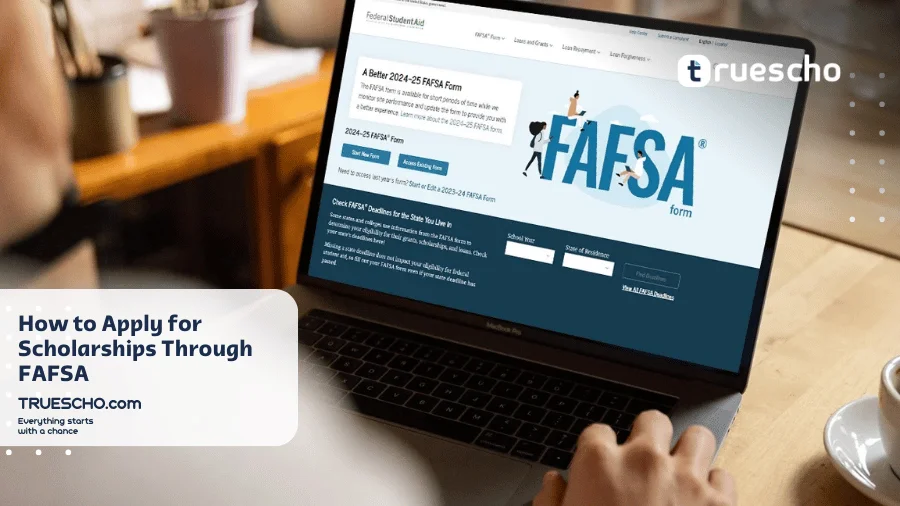The Free Application for Federal Student Aid (FAFSA) is a crucial tool for securing financial aid for your college education, including scholarships, grants, work-study programs, and federal student loans. Although FAFSA itself does not directly award scholarships, many universities and organizations use the information from your FAFSA to determine your eligibility for various scholarships, especially need-based awards. Completing your FAFSA is often the first step in the scholarship application process.
This guide will walk you through how to apply for scholarships through FAFSA, from the basics of filling out the form to understanding how FAFSA data is used to award scholarships.
Table of Contents
- What is FAFSA?
- Why FAFSA is Important for Scholarships
- Benefits of Filing FAFSA for Scholarships:
- Step-by-Step Guide to Completing the FAFSA
- Step 1: Gather Required Documents
- Step 2: Create an FSA ID
- Step 3: Complete the FAFSA Form
- Step 4: Submit FAFSA and Review Your Student Aid Report (SAR)
- Step 5: Follow Up with Colleges
- How FAFSA Data is Used for Scholarships
- Types of Scholarships You Can Access Through FAFSA
- Need-Based Scholarships
- Merit-Based Scholarships
- Tips to Maximize Scholarship Opportunities with FAFSA
- Important Deadlines
- Conclusion
- Additional Resources
What is FAFSA?
The Free Application for Federal Student Aid (FAFSA) is a form that students in the U.S. can submit to apply for financial aid for college or graduate school. The information you provide in your FAFSA helps the federal government, state governments, and colleges determine how much financial aid you’re eligible for.
While FAFSA primarily determines eligibility for federal student loans and grants, many colleges and universities use the information from your FAFSA to assess your financial need and offer scholarships.
Read also: Fully Funded Scholarships in Turkey
Why FAFSA is Important for Scholarships
Many colleges and universities award need-based scholarships based on the information provided in your FAFSA. Additionally, some merit-based scholarships require you to file the FAFSA to verify that you meet specific financial requirements. By completing your FAFSA, you open the door to a wide range of financial aid opportunities, including scholarships that may not require a separate application.
Benefits of Filing FAFSA for Scholarships:
- Need-based scholarships: Many institutions use FAFSA to determine eligibility for scholarships based on financial need.
- Automatic consideration: Some colleges automatically consider students for scholarships after receiving FAFSA data, without requiring a separate application.
- State and institutional aid: In addition to federal aid, FAFSA is used to allocate state and institutional scholarships and grants.
Step-by-Step Guide to Completing the FAFSA
Step 1: Gather Required Documents
Before starting your FAFSA application, make sure to have the following documents ready:
- Social Security Number (SSN) or Alien Registration Number (if you’re not a U.S. citizen).
- Driver’s license number (if you have one).
- Tax returns: You’ll need your most recent federal tax returns. If you’re a dependent, you’ll also need your parents’ tax information.
- Records of untaxed income: This includes child support, veteran benefits, and any other untaxed income.
- Bank statements and investment records: These help determine your financial status.
Step 2: Create an FSA ID
You will need an FSA ID to log in and sign your FAFSA form electronically. If you’re a dependent student, your parent or guardian will also need to create an FSA ID.
- Visit the FSA ID creation page to create your ID.
- Keep your FSA ID safe, as you’ll need it to access your FAFSA and federal student aid information.
Step 3: Complete the FAFSA Form
Once your FSA ID is set up, go to the FAFSA website and start filling out the form.
- Personal Information: Enter your name, Social Security Number, date of birth, and other personal details.
- School Selection: List the colleges you’re applying to so they can receive your FAFSA data.
- Financial Information: Use the IRS Data Retrieval Tool to automatically import tax return information into your FAFSA, or manually enter your financial information.
- Parent Information (if applicable): Dependent students need to provide their parents’ financial information.
Read also: Schwarzman Scholars Programme
Step 4: Submit FAFSA and Review Your Student Aid Report (SAR)
Once you’ve filled out the form, submit your FAFSA electronically. After submission, you’ll receive a Student Aid Report (SAR), which summarizes your financial information and provides your Expected Family Contribution (EFC)—a key figure used to determine your financial need.
- Review the SAR: Ensure all the information is correct and report any errors to the FAFSA office if needed.
Step 5: Follow Up with Colleges
Colleges will use your FAFSA data to create your financial aid package, which may include scholarships, grants, loans, and work-study opportunities.
- Check your financial aid offers: After being accepted to a college, review the financial aid offer letter, which details the types and amounts of aid you qualify for, including scholarships.
- Respond to offers: Accept or decline the various types of financial aid offered by each school.

How FAFSA Data is Used for Scholarships
Once you submit your FAFSA, colleges and universities use your financial information to assess your need-based financial aid eligibility. Many institutions automatically consider FAFSA applicants for institutional scholarships and grants, particularly those based on financial need.
Additionally, some merit-based scholarships require a FAFSA submission to determine your eligibility for additional financial assistance. Completing the FAFSA can increase your chances of receiving scholarships even if you do not initially qualify for need-based aid.
Types of Scholarships You Can Access Through FAFSA
Need-Based Scholarships
These scholarships are awarded based on your financial situation as assessed by your FAFSA. Schools use the Expected Family Contribution (EFC) to determine whether you qualify for need-based scholarships.
- Examples:
- Pell Grants: While not a scholarship, this federal grant is awarded based on financial need.
- Institutional Need-Based Scholarships: Many colleges offer scholarships for students with demonstrated financial need.
Merit-Based Scholarships
Some merit-based scholarships use FAFSA to assess if students are also eligible for need-based aid in addition to merit. Even if you qualify for merit-based scholarships, submitting FAFSA can increase your overall financial aid package.
- Examples:
- Presidential Scholarships
- Academic Excellence Scholarships
Read also: Best UK Scholarships for International Students
Tips to Maximize Scholarship Opportunities with FAFSA
- Submit Early: FAFSA becomes available on October 1st each year. Submit as early as possible, as some schools and states have limited scholarship funds awarded on a first-come, first-served basis.
- Complete FAFSA Every Year: Even if you received scholarships one year, you need to resubmit the FAFSA every year you’re in school to continue receiving financial aid.
- Check School-Specific Requirements: Some colleges may require additional forms or documentation for scholarship consideration.
- Monitor Deadlines: Be aware of federal, state, and institutional deadlines for submitting FAFSA to maximize your chances for scholarships.
- Keep Financial Records Organized: Make it easier to fill out the FAFSA by having all tax and financial documents ready and up to date.
Important Deadlines
- FAFSA Open Date: October 1st (for the following academic year)
- Federal FAFSA Deadline: June 30th of the academic year you are applying for
- State and Institutional Deadlines: Vary by state and institution (Check your state’s deadline here)
Conclusion
Completing the FAFSA is an essential first step toward accessing not only federal financial aid but also scholarships and grants provided by colleges, states, and external organizations. By submitting your FAFSA early, staying organized, and following up with colleges, you can maximize your chances of securing scholarships to help fund your education. Remember, FAFSA must be submitted every year you wish to receive financial aid, so stay on top of deadlines and requirements.
Additional Resources
- FAFSA Application Website: studentaid.gov
- Federal Student Aid Information: studentaid.ed.gov
- Scholarships.com: scholarships.com
- College Board Scholarship Search: bigfuture.collegeboard.org
Read also: How to Apply for Scholarships in the UAE
Take advantage of the FAFSA process to unlock various scholarships and financial aid opportunities for your college education.






